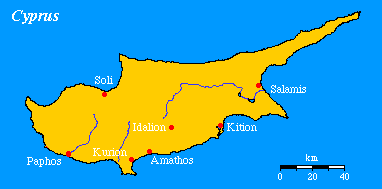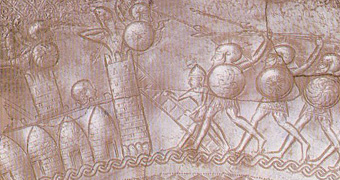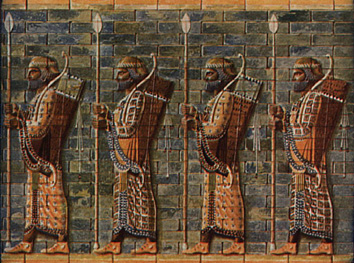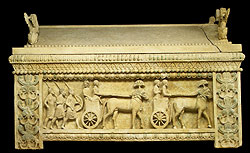Luke Ueda-Sarson's Historical Battle Scenarios for DBM:
The Battle of Salamis: ca. 496 BC

The Battle of Salamis: ca. 496 BC

Herodotos reports (Book 5, chapters 104-118) that during the Ionian revolt against Persia, Onesilos, brother of Gorgos, the ruler of Salamis-in-Cyprus (Sillu'ua) encouraged the Cypriots to throw off the Persian yoke. He shut Gorgos out of Salamis, and managed to incite all the other Cyprian towns to join revolt with the exception of Amathos, which Onesilus then laid seige to to compel its submission. Knowing the Persians would be sure to attempt to suppress the rebellion, Onesilos allied himself with the rebellious Ionians. Gorgos fled to the Persians, and returned with a Persian army lead by Artybios.

Onesilos' Ionian allies defeated the Persians' Phoenician fleet the same day that the Persian forces confronted the rebellious Cypriots on land, in the plain outside Salamis. Artybios was felled while fighting Onesilus' picked contingent composed of Salamites and Solians, but one of the other Cypriot contingents under Stesenor of Kurion (Kuri) deserted to the Persian side, followed by the Salamite chariots, which turned the tide of battle in the Persians favour, and Onesilos was killed in the subsequent rout, along with Aristocyprus, the ruler of Soli (Silli).
As a result, Gorgos was reinstalled in Salamis, and the other Cyprian towns, with the exception of loyal Amathos, were all beseiged and captured by the Persians within four months, putting an end to the revolt.

Nothing else is know of the battle, other than Persian were not the only nationality represented on the Persian side, since Herodotos mentions that while Onesilos' picked contingent faced the Persians, the other Cypriot towns faced the 'other enemy groups'. No troop numbers are given, although the Cypriot forces cannot have been overly numerous, given the Cypriots had offered to swap places with the Ionians before the battle. However, the Persians cannot have been very numerous either: the battle was won not by their numbers, but by the treachey of Stesenor's cotingent. Clearly the Persian army was much smaller than that lead against Athens at Marathon, so I would guess it numbered not much more than 10000 men.
|
It is possible that the loyal Amathians contributed a small contingent to the Persian side (the siege must have been abandoned when the Persians arrived, since the battles was fought not there but at Salamis); this will allow the battle to be classed as a 'civil war' under DBM, so that there is a chance that unreliable allied contingents can change sides, as happened, even though their generals are classified as regular.
To the right is a silver plate showing an attack on a Cypriot town from the 6th century BC. An interesting combination of Greek and Phoenician-style arms are employed.
|

|
Apart from Soli, Salamis and Kurion, other prominent Cypriot towns included Idalion (Edi'il), Tamassos (Tamesi) and Kition (Kitrusi the largest Cypriot town), some of which are likely to have contributed contingents to the battle. It seems likely that Onesilos was a populist politician, since his campaign involved the popular slogan of liberation from the Persians, as opposed to his pro-Persian brother who was no doubt supported by the aristocracy of Salamis, as in other Greek and Greek-influenced towns under Persian rule. This is all the more likely since when the Kurions deserted, they were followed by the chariots from Salamis, but not the other Salamites - the chariots would have been provided by the aristocratic nobility of course, and could be expected to be sympathetic to Gorgos' pro-Persian policy rather than Onesilos' revolutionary course.
At the usual scale of 250 men per element, I conjecture the opposing forces as the following:
The Persian side
1 x Reg Cv (O) CinC - Artybios
3 x Irr Cv (O) - Persian and Median horse
9 x Irr Bw (X) double-based with 9 x Irr Bw (O) - Persian and Median sparabara
6 x Irr Bg (I) - baggage, supplies, seige equipment and the like
1 x Reg Cv (O) sub-general - name unrecorded
3 x Irr Cv (O) - Persian and Median horse
4 x Irr Ps (S) - Pisidians
6 x Irr Ax (O) - Kappadokians
8 x Irr Bw (O) - Sakae and other Scythian bowmen
1 x Reg Kn (O) ally-general - Gorgos, his retainers and Amathians nobles in chariots
2 x Reg Kn (O) - other Amathian nobles in chariots
6 x Reg Sp (I) - Amathian hoplites
2 x Irr Ps (O) - Amathian archers
The Persian side comes to 272 AP, Artybios' command breaks on 8, the second on 7, Gorgos' on 3.5, and the army breaks on 26.
The Cypriot side:
1 x Reg Bd (F) CinC - Onesilos of Salamis
12 x Reg Sp (I) - Salamites and picked Solians
4 x Irr Ps (O) - Salamite archers
2 x Irr Bg (I) - Salmite baggage
1 x Reg Sp (I) ally-general - Aristocyprus of Soli
9 x Reg Sp (I) - other Solian hoplites
2 x Reg Kn (O) - Solian chariots
2 x Irr Ps (O) - Solian archers
2 x Irr Bg (I) - Solian baggage
1 x Reg Kn (0) ally-general - Stesenor of Kurion in chariot
1 x Reg Kn (O) - Kurian chariots
6 x Reg Sp (I) - Kurian hoplites
2 x Irr Ps (O) - Kurian archers
2 x Reg Kn (O) - Salamite chariots
2 x Irr Bg (I) - Kurian baggage
1 x Reg Kn (O) ally-general - an unnamed king of Kition
2 x Reg Kn (O) - chariots from Kition and other Cypriot cities
6 x Reg Sp (I) - hoplites from Kition and other Cypriot cities
2 x Irr Ps (O) - archers from Kition and other Cypriot cities
2 x Irr Bg (I) - Cypriot baggage
The Cypriot side comes to 305 AP; Onesilos' command breaks at 5, Aristocyprus' at 4.5, Stesenor's at 4 and the fourth command at 3.5. The Cypriot army breaks at 24.
Artybios, like other typical Persian generals, fought on horseback. According to Herodotos' tale, his horse was specially trained to rear up when fighting infantry. Alas this became known to Onesilos' shield-bearer, a Karian who managed to shear off the hooves of the horse with his 'drepanon', a curved slashing weapon, when Artybios fought personally against Onesilos.
|
According to Herodotos, Sakae, along with Persians and Medes, were regularly used as marines in the Persian fleet. They formed the centre of the Persian line, along with Persians themselves at the similar (if larger) expedition to Marathon, and they are the therefore the most likely group to be included first amongst the 'other enemy contingents'. Medes are also likely, as they essentially shared the goverment with Persian in many ways as well as military duties. Phoenicians would have been serving with the fleet on the day of the battle and so would not be present on the field - their reliability fighting against fellow Phoenician Cypriots might also be doubted, which I suspect is why the Cypriots asked the Ionians to swap places with them - if the Phoenician fleet realised it was to fight other Phoenicians it might have deserted the Persian side.
To the right are some of Darius' guards in full-dress uniform, taken from a frieze from his Palace in Susa. Such guards wouldn't have been included in the Persian army at Salamis, but the picture is too nice to pass up!
|

|
Since the Persian army had just crossed over from Kilikia, Kilikians and others from the nieighbourhood should also be expected in the army. The Kilikians themselves appear to have fought only as marines according to Herodotos' catalogue of Persian forces, so would not be present at the land battle, and similarly the Lykians, but the neighbouring Pisidians and Kappadokians would have fought on land. The number of Persian cavalry would likely have been low since horses are much harder to transport by ship than men are.
Most Cypriot forces at this time were equipped in the Greek manner according to Herodotos (except the kings who wore turbans) and therefore fought as hoplites, although chariot forces remained in use, and archers are depicted in art. I have decided Aristocyprus should best be represented as a general on foot, since he died in the rout like Onesilos; the other generals I have classed as mounted (on chariots) since they apparently survived. I have graded Onesilos as Bd (F) rather than Sp (I) because of his Karian drepanon-bearing hypaspist, and that it would be otherwise impossible for him to bring down Artybios if he was graded as Sp (I) - since (I) troops will always recoil on a tied result with (O) Cv there is no way that Artybios' element could 'stick' and be flanked (Sp can't destroy Cv frontally outright in DBM, even if they double them in combat). Grading him as Bd will also encourage the Persians to attack him with cavalry rather than archers.
|
The use of chariots in Cypriot warfare was in many ways a relic of its Phoenician past, but as can be seem from this sarcophagus from Amathos, dated to the mid 5th-century BC, and possibly belonging to the king himself, they were still in use after this period of the revolt. The other side of the sarcophagus shows two more chariots, one being driven by the king, accompanied by a parasol-bearer; the other with three crewmen.
The Amathos sarcophagus, from the Cesnola collection in the New York Metropolitan Museum. The foot soldiers following the vehicle indicate the chariot can be viewed in a military context. |

|
Fighting the battle:
The exact year the battle was fought in is not known with absolute precision, let alone the particular season or time of day, so determine these as normal, rerolling any result that calls for the Cypriots to be the invader. Having been committed to the Persain cause by Onesilus' seige, the Amathians under Gorgus count as a reliable ally even if Gorgus' first PiP score is a 1. The other Cypriot ally-generals may be unreliable however, and have the potential to desert mid-battle.
The battlefield location is unkown, other than it was on the plain by the city of Salamis, I assume that the battle was not fought right by the city, since otherwise the routing Cypriots might have been less easily cut down, and the city's presence is not mentioned as a factor in the battle. Since the naval battle fought nearby had no effect on the land battle, it must also be assumed that the battle was not fought adjacent to the sea, but it least some distance inland, so that a WW should not appear on the battlefield either. Therefore the terrain should be selected in the normal manner, but not include any hills, WW or BUA. This essentially means the Persians may position a road (but not have 3rd phase pick, since the Cypriot list contains no RGo), and the Cypriots must place a wood of at least one terrain equivalent size, and 2-3 other equivalents of woods, orchards, vineyards or roads, and roads (maximum of 2) only if the Persians have already positioned one. The Cypriots may also position a small river if desired - as one runs through the plain near Salamis. It must be depicted less than 50 paces across, and when dicing for fordability, halve the dice roll result (rounding fractions down) - the river is very small, and should pose no problems to crossing, except in early Spring when there is a possibility of snow-melt (there occasionally being snow in winter in the mounrtains). The battlefield should slightly smaller than standard size given the limited number of troops; if it is, reduce the number of defender's optional terrain picks from 2-3 to 1.5-2.5. Flank marches are allowed, representing contingents arriving late for the battle in the case of the Cypriots, or delayed by the Ionians in the case of the Persians.
Fight the battle until one side is broken. If the Persian side is broken, the Cypriots win an overwhelming victory, unless they themselves break that same bound in which case they win a marginal victory - either side might rally first, but such a set-back for the Persians, already in trouble in Ionia will probably lead to further revolts in places like Egypt. The Persians will win an overwhelming victory if they break the Cypriots without having a command demoralised and win a marginal victory if they break the Cypriots while having one of their own comamnds broken. Any other result is a draw.

This page last modified: 19 November, 2002. Thanks to Thomo-the-Lost for providing geographical informaton!
Return to my homepage index